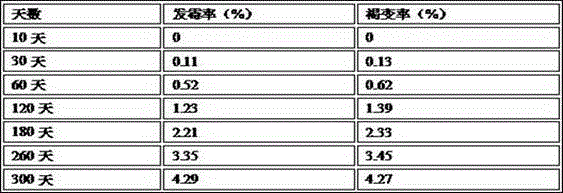Chestnut preservation method
A chestnut and seed technology, which is applied in the fresh-keeping field of Luotian chestnut, can solve the problems of browning taste, quality decline, mildew, etc., and achieve the effect of reducing browning rate, reducing moldy rate, and preventing insect damage
- Summary
- Abstract
- Description
- Claims
- Application Information
AI Technical Summary
Problems solved by technology
Method used
Image
Examples
Embodiment 1
[0055] (1) Fruit selection: select chestnuts that are free from pests, plump and harmless.
[0056] (2) antistaling agent treatment: soak 20 minutes with antistaling agent, the composition of antistaling agent is: catechin 0.04wt%, NaCl1wt%, salicylic acid 0.02wt%, tea polyphenols 0.6wt%, chitosan 8wt%, Citric acid 0.05wt%, vitamin E 0.3wt%.
[0057] (3) Soaking in clear water: Soak the chestnuts treated in step (2) with clear water at 40°C for 40 minutes.
[0058] (4) Biological treatment: Soak the processed chestnuts in step (3) with an aqueous solution containing strain b for 20 minutes, and dry them in the air; Used after culturing, fermenting and diluting to 600 times.
[0059] (5) Moisture control: Dry the chestnuts treated in step (4) with cold air to control the moisture content to about 40%, and the air-drying temperature is -12—-8°C.
[0060] (6) Cold storage: within 60 days of storage, the temperature is -2-0°C, and the humidity is 90-95%; for 60-120 days, the st...
Embodiment 2-6
[0062] The process of embodiment 2-6 is basically consistent with embodiment 1, and difference is: the composition of preservative is slightly different, and its percentage content is as shown in table 4:
[0063] Table 4
[0064]
[0065] Wherein, step 3 in Example 3 is soaked in water at 45°C for 30 minutes, and the fermentation broth in step 4 is diluted 500 times; step 3 in Example 6 is soaked in water at 50°C for 20 minutes, the fermentation broth in step 4 is diluted 1000 times, and the fermentation broth in step 5 is freeze-dried Control the moisture content to 42%. The mold rate and browning rate of the chestnuts treated in Examples 2-6 were preserved for 180 days and were less than 3.5%.
[0066] 1.7 Verification of the application effect of endophytic bacteria in the process of chestnut preservation
PUM
 Login to View More
Login to View More Abstract
Description
Claims
Application Information
 Login to View More
Login to View More - R&D
- Intellectual Property
- Life Sciences
- Materials
- Tech Scout
- Unparalleled Data Quality
- Higher Quality Content
- 60% Fewer Hallucinations
Browse by: Latest US Patents, China's latest patents, Technical Efficacy Thesaurus, Application Domain, Technology Topic, Popular Technical Reports.
© 2025 PatSnap. All rights reserved.Legal|Privacy policy|Modern Slavery Act Transparency Statement|Sitemap|About US| Contact US: help@patsnap.com



